Second time science mussels into the Mahurangi
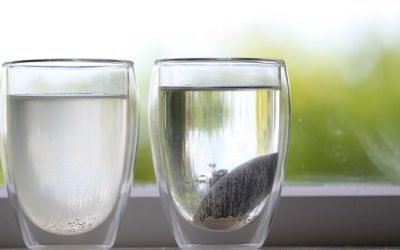
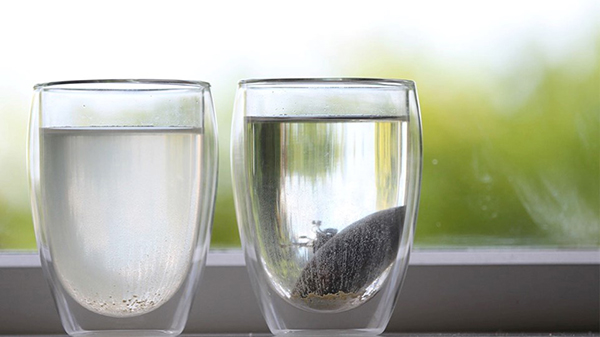
Show Stopper: The two glasses of Hauraki Gulf water didn’t look particularly dirty, until the one filtered by a single mussel, after less than 15 minutes, became crystal clear. The mussel reefs of the Hauraki Gulf were once so extensive—more than 500 square kilometres—that they filtered the waters in their entirety every two days. image Shaun Lee
The first time science brought its muscle to bear was in 2004.
After ten years of studies aimed at baselining selected catchments ahead of urban development impacts, the scientists involved persuaded the former Auckland Regional Council that urgent intervention was required to address the Mahurangi Harbour’s elevated sediment accumulation rate.
The result was a $3 million five-year action plan to kickstart riparian fencing and planting in the Mahurangi watershed. Not all locals were pleased with the plan. Some because it threatened to side-line their cherished sewage or foreshore-erosion bête noires, others because of the overly narrow focus on riparian fencing. Strong community participation resulted in a broadening of focus, to embrace even the community-led determination to restore the navigability of the Mahurangi River, by dredging.
Having learned that deforestation had set in train a sedimentation crisis, the focus, rightfully, has been on the land, and mitigating the more egregious ongoing sources of sediment generation there. Many, however, had to be persuaded that mangrove proliferation was the result of sedimentation, not the cause of it. Some refused to be persuaded—far more visceral to tear into the hateful mangroves with chainsaws, than ponder the result of unprotected muddy shorelines and a bit of wave action to resuspend the extra sediment.
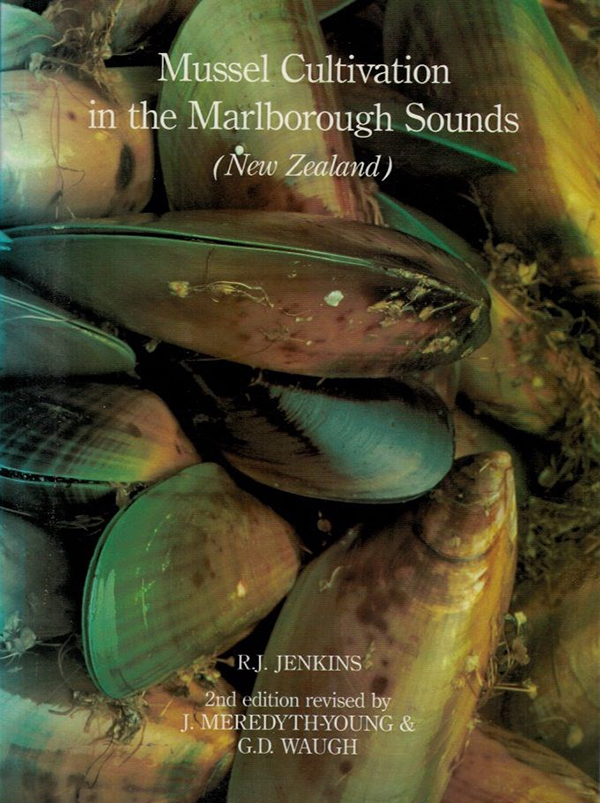
Sounds Connections: Bizarrely, the Mahurangi shared a strong bond with the Marlborough Sounds when Blenheim-based Regal Salmon purchased the Mahurangi West-based salmon smokehouse The Food Connection, in 1989. Seattle-born New Zealandophile, Regal Salmon co-founder and scientist, the late, great R James ‘Jim’ Jenkins, 1947–2017, introduced the successful hanging culture mussel-growing methods to Aotearoa from Japan, and literally wrote the book on how to farm mussels in Aotearoa. Mahurangi West personnel established Regal Salmon’s first South Island smokehouse, in Invercargill. publisher New Zealand Fishing Industry Board
But, the Mahurangi was yet to learn, there was another reason for the muddy waters not only its harbour, but of the Hauraki Gulf generally: Deforestation of the seabed. Dredging of green-lipped mussels, between the mid-1920s and mid-1960s, but mostly in the latter two decades, denuded the seabed even more comprehensively than had occurred on land. The terrestrial conservation tradition that saw forest reserves created and cherished following the passing of the 1884 State Forests Act was absent beyond the shoreline. Mussel dredges were allowed to rape the seabed and leave a largely lifeless, barren seafloor where previously a rich benthic community had flourished for millennia. Once done, the dredges decamped to Nelson–Marlborough to similarly destroy the ocean floor there, before turning their attention to west coast shorelines, which were only saved from similar annihilation by farmed green-lipped mussels flooding onto the market for the first time.
Fatally, for water quality, at the same time that the effects of deforestation and poor or inappropriate land-use practices were peaking, the one force that the Hauraki Gulf had in reserve to counter the elevated sediment accumulation rate, the green-lipped mussel, was being bodily carted from the battlefield. More than 500 square kilometres of mussel beds were torn out—harvested is much too noble a word—and left with no means of regeneration, just when they were needed most. Before their removal, the mussel beds filtered the waters of the Hauraki Gulf, in their entirety, in two days. Crucially, carbon dioxide absorbing phytoplankton thrives when sunlight can penetrate the water column. Given that, and the habitat the mussel beds provide juvenile fish such as snapper, it is highly improbable that contemporaneous collapse of the Hauraki Gulf snapper fishery was coincidental with the removal of the mussel reefs.
In 2012, niwaNational Institute of Water and Atmospheric Research marine ecologist Dr Darren Parson suggested restoring green-lipped mussel beds, within their former range. In December the following year the first mussels were deposited, off eastern Waiheke Island, supervised by Dr Andrew Jeffs, and Dr Shane Kelly from the then recently formed Mussel Reef Restoration Trust. Within months the success of the initial beds was apparent, with the mussels doing what they do to survive on the seabed: use their footscollectively, feet, but couldn’t resist the opportunity to use foots, if only to emphasise that each mussel has but one, but possession of a foot makes the mussel sufficiently mobile to allow it to reach a suitable attachment surface to clump together, then their byssal threads to attach to each other. A total of about 3.5 million mussels are subsequently deposited off eastern Waiheke Island.
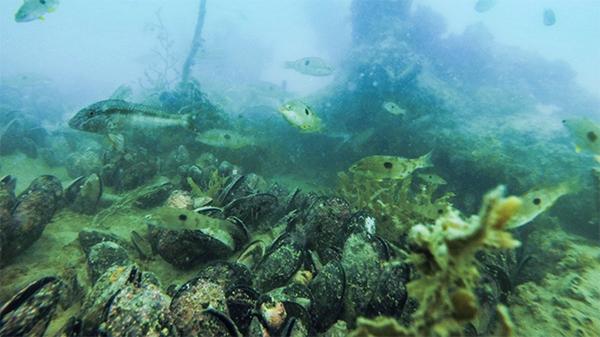
Future Mahurangi Harbour Seafloor: Initial trials have shown that even the Mahurangi Harbour with its elevated sediment accumulation rate can be restored by dropping farm-raised green-lipped mussel overboard, where they happily and co-operatively find neighbours to which to attach themselves. In turn, habitat is provided for goatfish, juvenile snapper, kōheru, spotties, and squid. The challenge for the community now is to devise an achievable programme for restoring mussel reefs in the Mahurangi at scale. image Shaun Lee
In 2016, restoration trials were attempted in the Mahurangi Harbour, and despite its famously high sediment accumulation rate, within a year the pioneers were right at home, with the reefs providing habitat for goatfish, juvenile snapper, kōheru, spotties, and squid. Last year 50 tonnes were deposited in beds from Casnell to Motuora islands. Mahurangi Action’s Jim Dollimore donated his company’s barges and workers’ time to distribute the mussels, the financial costs of which were largely met by a grant from the Ministry for the Environment’s Community Environment Fund.
Wednesday’s Warkworth Town Hall Talk treated locals to Dr Andrew Jeffs’ profound perspective of the lamentable history of the Hauraki Gulf plunder and message of hope for its restoration, whilst not downplaying the enormity of the task of restoring more than a fraction of the former glory of its mussel reefs. And while the talk was embarrassingly poorly attended, the ‘crowd’ included several key people, one of which has subsequently made the unsolicited offer of a substantial, five-year philanthropic contribution to furthering Mahurangi mussel reef restoration. The philanthropist is a believer in community action and wants the project to be owned by the Mahurangi, and initial indications from other town-hall talk attendees is that they are unhesitatingly onboard. Had the audience been handpicked, a more fulsome response could not have been hoped for.
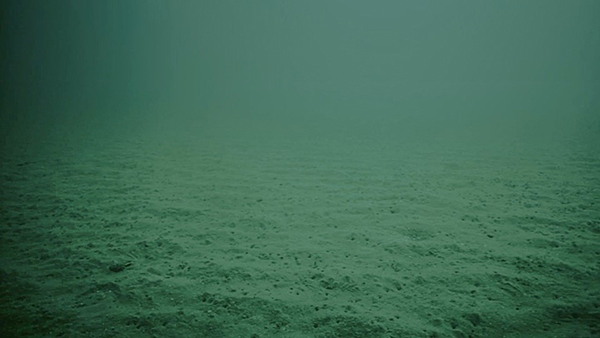
Seafloor Sans Mussel Reefs: Typical, denuded Hauraki Gulf seabed photographed this year. The Mahurangi Harbour is no better, with the turbidity almost certainly worse than in this example. Replacing the 500 million square metres of gulf mussel reefs torn out in mostly within two decades mid last century is mammoth task. After six years and about 10 million mussels, reefs have been established covering about 0.03% of the area lost. But more is being learned all the time about how to optimise mussel reef restoration, which will greatly benefit a Mahurangi mussel reef restoration programme, and vice versa. image Shaun Lee
This development alone demands the updating of the Mahurangi Action Plan: A Catchment Plan 2010–2030. It is the shot-in-the-arm needed to re-engage the Mahurangi community in the long-term plan to protect the watershed to the greatest degree practicable, in the face of increasingly extreme, extreme rainfall events, fossil-fuelled. The bulk of sediment generated in the Mahurangi watershed, is typically generated in one or two extreme rainfall events in a year, meaning that the work of protecting the harbour is only going to get more difficult. It is a daunting prospect, which makes the Mahurangi mussel reef restoration project, with its immediate beneficial impact, such as the sanctuary provided to juvenile snapper, even more important to engaging the community. In fact, behavioural phycologists would no doubt counsel against connecting the dots with global warming, lest the faint hearted be discouraged from engagement. But humanity been has trying the don’t-scare-the-horses, Ignorital© response, without conspicuous success. After three decades of determined climate inaction, the only thing that has changed is that politicians can now talk about climate nuclear-free moments without fear of universal derision, but, more worryingly, without the slightest twinge of irony.
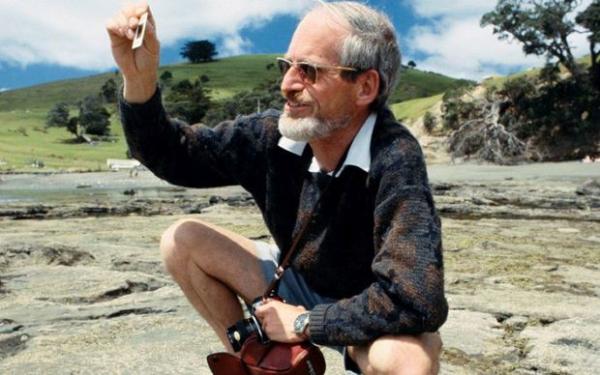
Sadly Still a Rarity: Despite his legendary work leading to the establishment of New Zealand’s first marine reserve, in 1976, less than 1% of the coastline has been so protected—tellingly, the large reserves, as magnificent as they are, are far offshore, safely beyond the political clout and selfish instincts of organised recreational fishers. Ironically, public perception is that a third of the coastline is protected. Cowardice of the political élite in respect to marine reserves is only matched by its cravenness in respect to meaningful climate action. Meantime, much of Dr Andrew Jeffs’ working career has been based at the Leigh Marine Laboratory, surrounded by that first, marvellous, marine reserve. image Kennedy Warne
Added to global warming is the current earth disturbance on a scale unprecedented since the 1800s deforestation, to fossil-fuel-build a motorway for fossil-fuelled vehicles, to supercharge the satellite-growth-centre growth of Warkworth. This leaves the immediate fate of the Mahurangi watershed at the mercy of the timing of extreme rainfall events. However, the long-term fate of the Mahurangi is in the hands of a community with the courage to demand politicians take its protection seriously.
And a bold Mahurangi mussel reef restoration programme is just the thing to recruit that essential Mahurangi community support.
Source Although the bulk of the information for this article came from Dr Andrew Jeffs’ 8 August Warkworth Town Hall Talk presentation, any errors and misconceptions are entirely those of the writer.
